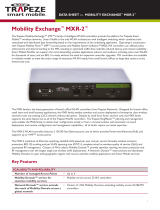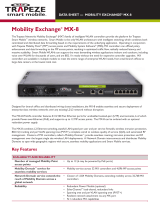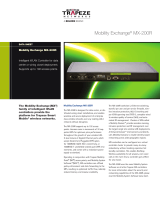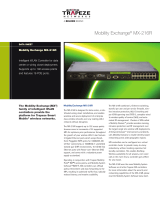Page is loading ...

Intelligent WLAN Controller for
data center deployment. It offers 28
Gbps of switching throughput and
supports up to 512 802.11n APs.
Mobility Exchange
®
MX-2800
DATA SHEET
Mobility Exchange MX-2800
The Mobility Exchange
(MX
®
)
family of intelligent WLAN
controllers provide the
platform for Trapeze Smart
Mobile
®
wireless networks.
The Trapeze Mobility Exchange
®
MX-2800 is the
next generation Smart Mobile
®
WLAN control-
ler for medium to large size enterprise WLAN
deployments. It brings unprecedented scal-
ability, manageability, reliability and resiliency
features to WLAN networks, mirroring the user
experience of wired networks.
Powered by Trapeze’s unique hardware-acceler-
ated WLAN processing engine and a high speed
security co-processor, the MX-2800 scales to
support the most demanding wireless applica-
tions indoors and outdoors, including voice over
Wi-Fi for thousands of users. It offers 28 Gbps
of throughput and supports up to 512 802.11n
APs while providing NonStop availability and
hitless failover with no service interruption,
even in the unlikely event of a controller failure.
Smart Mobile is the only WLAN architecture
that offers intelligent switching, which com-
bines both centralized and distributed data
forwarding based on the requirements of the
underlying application. Operating in conjunc-
tion with Trapeze Mobility Point
®
(MP) access
points, and Mobility System Software
®
(MSS),
MX controllers can offload policy enforcement
and data forwarding to the MPs, resulting in
optimized traffic flow, radically reduced latency,
and massive scalability.
The MX-2800 is the latest generation of WLAN
controllers from Trapeze Networks. Designed for
data center or distributed wiring closet installa-
tions, the MX-2800 enables seamless and secure
deployment of enterprise class wireless networks
over any existing L2/L3 network without disrup-
tion.
The MX-2800 combines L2 Ethernet switch-
ing, stateful per user and per service firewalls,
wireless intrusion protection, 802.1Q trunking
and per VLAN spanning tree (PVST+), complete
wired to wireless quality of service (QoS), and
automated RF management. Clusters of MXs
form a Mobility Domain™ which provides
seamless roaming, intrusion protection and RF
management over large single site wireless LAN
deployments. A Network Domain™ intercon-
nects Mobility Domains to support multiple sites
and span wide geographic regions with secure,
seamless mobility applications and Smart Mobile
services.
Mobility Exchange MX-2800

2
Key Features
Scalability and Reliability
Ports and Interfaces • 8 x GE pluggable SFP and 10/100/1000Base-T RJ45
• 2 x 10GE pluggable XFP
Number of managed Access Points • Up to 512 APs in increments of 64 Access Points licenses
Network Domain™ service extends the reach of • Cluster of 1,024 Mobility Domains, extending mobility across 32,768 MX controllers
Mobility Domain across a global network
Reliability • Always-on availability and hitless failover with no service interruption for voice and data clients even in the unlikely event
of a controller failure
• Hot pluggable redundant power supply
• Hot pluggable fan tray module
• EtherChannel™ load-shared, redundant links
• Spanning tree and per-VLAN spanning tree (PVST+)
• Resilient network attachment via any MX port
• N:1 and N:N redundant MX capabilities
Security
Authentication • Supports complete local AAA authentication, including 802.1x, as primary or backup to a centralized AAA server
• Supports multiple AAA server groups and can load share across multiple AAA servers or within a server group
• Generates and manages X.509 digital certificates
• Assigns and enforces per-user authorization policies that are managed centrally from the AAA back-end
• Authorizations include virtual private group membership, personal firewall filters, time-of-day/day-of-week access, encryption type,
and location-specific policies
• IEEE 802.1x with multiple EAP types (TLS, PEAP/MSCHAP, TTLS)
• WebAAA, MAC, Open
• WiFi WPA2 Enterprise certified
Encryption Key Management • Encryption distributed in Mobility Point access points
• MX generates master and session keys
• Provides key management for each encryption technique
Identity-based Networking • User credentials define access and network resource privileges
• Privileges and services follow users as they roam
• Maintains a user’s membership in the right virtual private group based on the user’s authenticated identity
• Dynamically enables Virtual Private Groups to support roaming across router boundaries
• Centralized management and control
Endpoint assurance • Trusted Computing Group (TCG) - Trusted Network Connect (TNC) compliant
• Microsoft NAP compliant
Intrusion Detection and Protection • ActiveScan™ rogue and denial-of-service (DoS) attack detection — Scans all bands, associated channels and VLANs, while
simultaneously providing wireless connectivity to mobile clients
• SentryScan™ — Scans the air continuously on both bands and their associated channel while other MPs support wireless LAN clients
• Rogue detection, Intrusion Detection System (IDS) and RF countermeasures
• Trapeze/AirDefense integrated Intrusion Detection and Prevention
- Best in class IDS/IPS
- Common Trapeze MP hardware for sensor and service APs
- Dynamic threat management- convert MPs to sensors on demand
- Threat location and mitigation
Mobility Services
Data Services • Data-intensive applications
• Latency-sensitive applications
Standards-based toll quality voice service • VoIP protocol support
• 802.11 e/WMM compliant
• Queuing and priority (802.11e/WMM)
• Preserve voice priority across network (802.11i PMK cache, WMM)
• Bandwidth control for voice (TSPEC)
• Maximize handset battery life (U-APSD)
• Neighbor report assisted roaming (802.11k)

Virtual service sets • Multiple SSID support (64 per MP, 32 per radio)
• Any mix of crypto and authentication per SSID
• Any VLAN topology per SSID
• Unique portal page per SSID
• Private or shared authentication
Guest Services • SmartPass
™
enables fast and simple configuration for guest access
• 64 web portals for customized user group profiles
• GuestTunneling to isolate guest traffic across the corporate network
High speed data services (802.11n) • 802.11n ready
• Direct Data Path Forwarding enables local switching of data traffic in the Mobility Point or forwarding of data to Mobility Point
upstream or downstream
• Mobility Point configured by MX for Direct Data Path Forwarding
Outdoor services • Wireless backhaul (P-P, P-MP) and Wireless bridging (P-P, P-MP)
•EnterpriseEthernetmeshservicewithMeshPortalandMeshAccessPointServiceswithDirectDataPathsupport
• Integrated control and management with indoor Smart Mobile services
Real time location services • WiFi based active RFID location technology (client and network based)
• Integrated with Location appliance
Management and Control
Management access • Command Line Interface (SSH v2)
• WebView web access (https)
• SSL, XML (to RingMaster
®
)
• SNMP v1, v2c, v3
RF Management • Automated MP Power/channel auto-tuning
• Dynamic Frequency Selection (DFS)
Clustering • An MX cluster is a set of MX controllers that are managed as a single entity - a virtual stack. It allows users to scale easily
and configure, monitor and troubleshoot MXs and APs through a single point of entry.
User management and statistics • Detailed per user per session RF accounting statistics and management
• Tracks the location, roaming history, virtual private group, network addresses, state, activity, errors, usage and other
attributes by user name, session, VLAN, or user group
• Provides per user audit trail and chargeback capability through the accounting component of AAA
MP management and control • Configures and controls MPs; controls third party APs
• The MX is categorized as an access controller (AC) that supports direct, switched, and routed connections
• Enables data forwarding in MX or in MP with Smart Mobile technology
• Multiple MXs provide resilient control
Direct Data Path Forwarding • MP configured to switch data traffic locally or forwarded to the MPs downstream or upstream
• Optimizes network and MX capacity and performance
• Control retained in MX
Client load balancing • Equalizes the number of client sessions amongst grou-ps of radios that have substantially overlapping coverage areas
• Restores equality of numbers of sessions when an AP is added to a group or is brought back up after a transient failure
• Allows a balanced group of APs to span multiple MX’s in a mobility domain
Client band steering • Enables client steering across bands for efficient usage of the available spectrum, and reduce network load on the
congested 2.4 GHz band
3

Hardware Specifications
Dimensions (W x D x H) • 17.4 in x 18 in x 2.594 in
• (44.19 cm x 45.72 cm x 6.58 cm)
Weight • 18 lbs (8.1 kg) with one power supply
• 19.5 lbs (8.77 kg) with two power supplies
Interfaces • 8 x Gigabit Ethernet Small Form-Factor Pluggable (SFP) ports
• 8 x Gigabit Ethernet RJ45 ports
• 2 x 10 Gigabit Ethernet Small Form-Factor Pluggable (XFP) ports
Environmental • Operating temperature: 0
0
C to 50
0
C
• Storage temperature: -40
0
C to 70
0
C
• Humidity: 10% - 90% (non-condensing)
Power • 100-240 VAC 50-60 Hz
Regulatory Safety • UL 609501-1, CB IEC 609501-EN, TUV/GS (EN #s) EN 60950, CSA C22.2 NoO, 60950-1-03
EMI/EMC • FCC Part 15 Class A
• ICES Class A
• VCCI Class A
• EN 55022 Class A
• EN 55024
• CISPR 22 Class A
• Taiwan: CNS 13438 Class A
• China: CCC GB 9254-88 Class A
• Australia/New Zealand: AS/NZ 3548 Class A
Supported Standards
Security and AA RFCs • RFC 2246 Transport Layer Security (TLS)
• RFC 2284 EAP
• RFC 2315 PKCS #7: Cryptographic Message Syntax Ver 1.5
• RFC 2548 Microsoft RADIUS VSAs
• RFC 2716 PPP EAPTLS Authentication Protocol
• RFC 2759 Microsoft PPP CHAP Extensions, Version 2
• RFC 2865 RADIUS Authentication
• RFC 2866 RADIUS Accounting
• RFC 2869 RADIUS Extensions
• RFC 2986 PKCS #10: Certification Request Syntax Ver 1.7
• RFC 3580 IEEE 802.1x RADIUS Guidelines
IEEE Standards • 802.1X: Port Based Network Access Control
• 802.3u: 100 BASE-TX Fast Ethernet
• 802.3ab: 1000 BASE-TX Gigabit Ethernet
• 802.3ae: 10 Gigabit Ethernet
• 802.11a/b/g/n, 802.11d, 802.11e, 802.11h, 802.11i, 802.11k
General • RFC 1122 Host requirements
• RFC 1393 Traceroute
• RFC 1519 CIDR
• RFC 1591 DNS
• RFC 2030 SNTP
• RFC 768 UDP
• RFC 783 TFTP
• RFC 791 IP
• RFC 792 ICMP
• RFC 793 TCP
• RFC 826 ARP
• IEEE 802.1D Spanning Tree
• IEEE 802.1Q VLAN tagging
• IEEE 802.3ad (static config)
4
Specifications

Management and Control • RFC 854 Telnet (server and client)
• SSHv2 - Secure Shell V2
• SNMP v1, v2c, v3
• RFC 1213 MIB-II
• RFC 1866 HTML
• RFC 2068 HTTP
• RFC 3164 Syslog
• Trapeze private MIB
IP Multicast • RFC 1112 IGMP v1
• RFC 2236 IGMP v2
Quality of Service (QoS) • 802.11e, Wi-Fi Multimedia (WMM)
• SpectraLink Voice Priority (SVP)
• RFC 2472 DiffServ precedence
• RFC 2597 DiffServ Assured Forwarding
• RFC 2598 DiffServ Expedited Forwardin
Ordering Information
MX-2800-xx • MX-2800 with two 10 GbE XFP ports and 8 x 1000Base-T (RJ-45 and SFP) ports, including 64 MP license, single PSU.
MX-2800-U64 • 64 MP license upgrade for MX-2800 (max. 512 MPs)
MX-2800-PSU-xx • PSU for MX-2800 redundant power or spare
5
© 2008 Trapeze Networks, Inc. www.trapezenetworks.com
DS_MX2800_100608
/









